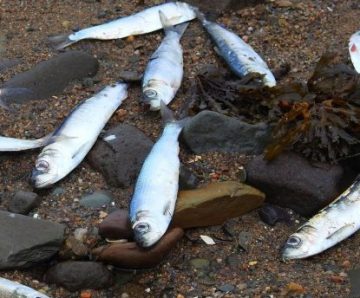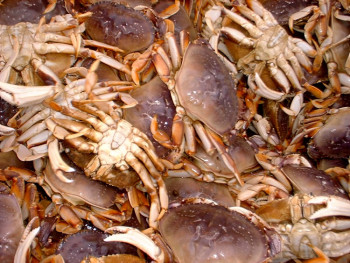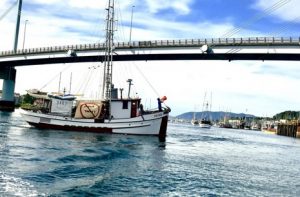Daily Archives: December 17, 2016
A mysterious phenomenon – Schools of dead herring continue to wash up on Nova Scotia beaches
 Schools of dead herring keep washing ashore along the rocky beaches of western Nova Scotia, prompting a retired scientist to enlist the help of local naturalists and bird watchers as he continues to gather data about the mysterious phenomenon. Ted Leighton, an adjunct biology professor at Nova Scotia’s University of Sainte-Anne, said Friday he has compiled more than 40 sightings since tens of thousands of dead and dying fish started appearing in St. Marys Bay in late November. The event does not appear to be over,” he said in an interview. “Whether it’s diminishing or not is really hard to say.” On Wednesday, federal scientists said they had yet to determine what is causing the die-off, despite a battery of tests. Negative results have been reported for physical damage and several types of bacterial infections and viruses. Fisheries and Oceans Canada says more tests are expected, including a check by the Canadian Food Inspection Agency for toxins caused by algae, and the possible presence of domoic acid — a toxin sometimes found in shellfish. Read the rest of the story here 16:53
Schools of dead herring keep washing ashore along the rocky beaches of western Nova Scotia, prompting a retired scientist to enlist the help of local naturalists and bird watchers as he continues to gather data about the mysterious phenomenon. Ted Leighton, an adjunct biology professor at Nova Scotia’s University of Sainte-Anne, said Friday he has compiled more than 40 sightings since tens of thousands of dead and dying fish started appearing in St. Marys Bay in late November. The event does not appear to be over,” he said in an interview. “Whether it’s diminishing or not is really hard to say.” On Wednesday, federal scientists said they had yet to determine what is causing the die-off, despite a battery of tests. Negative results have been reported for physical damage and several types of bacterial infections and viruses. Fisheries and Oceans Canada says more tests are expected, including a check by the Canadian Food Inspection Agency for toxins caused by algae, and the possible presence of domoic acid — a toxin sometimes found in shellfish. Read the rest of the story here 16:53
Southeast Alaska Dungeness fall harvest was lower than expected
 The fall harvest was approximately 403,000 pounds. That’s about 150,000 pounds less than last year. Kellii Wood is a Crab Biologist with the Alaska Department of Fish and Game. She says they’ve seen harvests like this before but it’s been a while. “It’s definitely down from previous years,” Wood says. “We have been lower but I believe it was in the 90s.” Wood says the harvest is far below the five year fall average of 732,000 pounds. About one-fifth of the year’s harvest comes in the fall. This year was just a little below that. Wood says the recent average is a bit skewed when you consider 2014. It was an unusually good year seeing the third highest fall harvest on record since the 1960s. That fall fishermen harvested about a million pounds. Listen to the audio report here 13:55
The fall harvest was approximately 403,000 pounds. That’s about 150,000 pounds less than last year. Kellii Wood is a Crab Biologist with the Alaska Department of Fish and Game. She says they’ve seen harvests like this before but it’s been a while. “It’s definitely down from previous years,” Wood says. “We have been lower but I believe it was in the 90s.” Wood says the harvest is far below the five year fall average of 732,000 pounds. About one-fifth of the year’s harvest comes in the fall. This year was just a little below that. Wood says the recent average is a bit skewed when you consider 2014. It was an unusually good year seeing the third highest fall harvest on record since the 1960s. That fall fishermen harvested about a million pounds. Listen to the audio report here 13:55
Crescent City Harbor – Plump crab off the F/V Dynamik
 The frenzy may have died down at the Crescent City Harbor, but Derrick Horn and other dock workers for Caito Fisheries were still pulling Dungeness crab from their boats on Tuesday. Horn and his crew unloaded 72,000 pounds of claw clacking crustaceans off the F/V Dynamik of Brookings, the largest boat in Caito’s Crescent City fleet. The vessels the seafood buyer uses are still staying full and the crab are excellent, Horn said. “They’re better than average from the last four years,” he said of the catch so far. “I just measured one I thought was small and it was (still) good size.” Two weeks after the season opened on Dec. 1, activity on Citizen’s Dock appears to have dropped off. Smaller boats are coming in with lighter loads, according to Horn. And Crescent City Harbormaster CEO Charlie Helms notes there are fewer refrigerated trucks waiting to be loaded. But crabbers are still plying their trade in Del Norte waters and getting $3 per pound, Helms said. “They’re still catching,”,,, Read the story here 12:43
The frenzy may have died down at the Crescent City Harbor, but Derrick Horn and other dock workers for Caito Fisheries were still pulling Dungeness crab from their boats on Tuesday. Horn and his crew unloaded 72,000 pounds of claw clacking crustaceans off the F/V Dynamik of Brookings, the largest boat in Caito’s Crescent City fleet. The vessels the seafood buyer uses are still staying full and the crab are excellent, Horn said. “They’re better than average from the last four years,” he said of the catch so far. “I just measured one I thought was small and it was (still) good size.” Two weeks after the season opened on Dec. 1, activity on Citizen’s Dock appears to have dropped off. Smaller boats are coming in with lighter loads, according to Horn. And Crescent City Harbormaster CEO Charlie Helms notes there are fewer refrigerated trucks waiting to be loaded. But crabbers are still plying their trade in Del Norte waters and getting $3 per pound, Helms said. “They’re still catching,”,,, Read the story here 12:43
Plan for Dusky shark doesn’t please Oceana cons
 The federal government isn’t going far enough with a plan to protect a threatened shark that lives off the East Coast and has been decimated by the fin trade, some conservationists argue. The National Marine Fisheries Service is proposing changes to federal fishing rules with the goal of protecting dusky sharks, a large species that is down to about 20 percent of its 1970s population off the East Coast and in the Gulf of Mexico because of commercial fishing for the species that’s now illegal off the U.S. Dusky sharks were long hunted for their meat and oil, as well as their fins, which are used to make soup in traditional Chinese cooking. The fisheries service is proposing a suite of new rules for recreational and commercial fishermen designed to protect the shark, which is sometimes still killed via accidental bycatch by fishermen seeking other species. But conservation group Oceana said the rules aren’t strict enough and leave the sharks vulnerable. Read the story here 11:29
The federal government isn’t going far enough with a plan to protect a threatened shark that lives off the East Coast and has been decimated by the fin trade, some conservationists argue. The National Marine Fisheries Service is proposing changes to federal fishing rules with the goal of protecting dusky sharks, a large species that is down to about 20 percent of its 1970s population off the East Coast and in the Gulf of Mexico because of commercial fishing for the species that’s now illegal off the U.S. Dusky sharks were long hunted for their meat and oil, as well as their fins, which are used to make soup in traditional Chinese cooking. The fisheries service is proposing a suite of new rules for recreational and commercial fishermen designed to protect the shark, which is sometimes still killed via accidental bycatch by fishermen seeking other species. But conservation group Oceana said the rules aren’t strict enough and leave the sharks vulnerable. Read the story here 11:29
Shell Canada asks regulator to leave huge pipe on sea floor off Nova Scotia
 Shell Canada has officially applied to abandon two kilometres of pipe it accidentally dropped on the ocean floor off the coast of Nova Scotia. The pipe, known in the industry as a riser, broke free from a surface ship March 5 during a winter storm. “Because of the unacceptable risk associated with the health and safety exposure and potential impact to human health of offshore workers, Shell does not perceive recovery of the riser … as a viable response option,” Shell Canada’s exploration manager said Friday in a letter to Canada-Nova Scotia Offshore Petroleum Board. “Considering the health and safety exposure associated with recovery, the minimal impact to other ocean users, as well as the lack of significant adverse environmental effects, leaving the riser … in place on the seabed is Shell’s safest and most appropriate response option.” Read the story here 09:54
Shell Canada has officially applied to abandon two kilometres of pipe it accidentally dropped on the ocean floor off the coast of Nova Scotia. The pipe, known in the industry as a riser, broke free from a surface ship March 5 during a winter storm. “Because of the unacceptable risk associated with the health and safety exposure and potential impact to human health of offshore workers, Shell does not perceive recovery of the riser … as a viable response option,” Shell Canada’s exploration manager said Friday in a letter to Canada-Nova Scotia Offshore Petroleum Board. “Considering the health and safety exposure associated with recovery, the minimal impact to other ocean users, as well as the lack of significant adverse environmental effects, leaving the riser … in place on the seabed is Shell’s safest and most appropriate response option.” Read the story here 09:54
Statoil Wins Offshore Wind Lease in NY for cheap money
 With Statoil being the provisional victor, the Norwegian giant said it will now have the opportunity to explore the potential development of an offshore wind farm to provide New York City and Long Island with a significant, long-term source of renewable electricity. Statoil Winds U.S. LLC bid almost $42.5 million for the rights to almost 80,000 acres of water beginning 12 miles from the coast. Statoil subsidiary Statoil Wind US LLC must pass federal agency reviews before it can open a one-year preliminary lease – and a hearing in U.S. District Court, where a February 8 date has been set to hear commercial fishermen’s motion for an injunction against the lease. The auction covered 79,350 acres of ocean real estate – roughly 127 square miles – between the southern Long Island and northern New Jersey coasts, and as the saying goes, things accelerated fast: Statoil Wind’s winning bid of $42.46 million was a far cry from the $158,700 (roughly $2 per acre) opening bid required by the Interior Department’s Bureau of Ocean Energy Management. Read the rest here 08:27
With Statoil being the provisional victor, the Norwegian giant said it will now have the opportunity to explore the potential development of an offshore wind farm to provide New York City and Long Island with a significant, long-term source of renewable electricity. Statoil Winds U.S. LLC bid almost $42.5 million for the rights to almost 80,000 acres of water beginning 12 miles from the coast. Statoil subsidiary Statoil Wind US LLC must pass federal agency reviews before it can open a one-year preliminary lease – and a hearing in U.S. District Court, where a February 8 date has been set to hear commercial fishermen’s motion for an injunction against the lease. The auction covered 79,350 acres of ocean real estate – roughly 127 square miles – between the southern Long Island and northern New Jersey coasts, and as the saying goes, things accelerated fast: Statoil Wind’s winning bid of $42.46 million was a far cry from the $158,700 (roughly $2 per acre) opening bid required by the Interior Department’s Bureau of Ocean Energy Management. Read the rest here 08:27












































